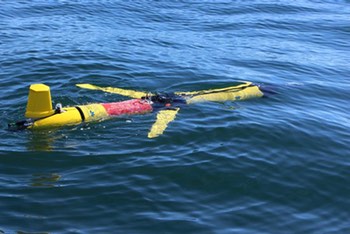 Over the past few years, researchers have developed an increasingly diverse set of platforms for listening in on the world beneath the ocean’s waves. Now, in addition to recorders deployed in key areas for months at a time and temporary suction-cup acoustic tags on individual whales, a long-anticipated mobile option is moving into more widespread use. Autonomous gliders offer an enticing combination of attributes: they can operate for weeks or months at a time, exploring a region rather than staying in one place; they can be outfitted with a range of sampling capabilities; and they are relatively inexpensive to build and deploy. Subsea gliders can dive to 200 meters deep and resurface periodically to transmit data to data centers on shore; they’ve been used for physical sampling of oceanographic data (temperature, salinity, etc.) for many years, but it’s only more recently that acoustic sampling has become common.
Over the past few years, researchers have developed an increasingly diverse set of platforms for listening in on the world beneath the ocean’s waves. Now, in addition to recorders deployed in key areas for months at a time and temporary suction-cup acoustic tags on individual whales, a long-anticipated mobile option is moving into more widespread use. Autonomous gliders offer an enticing combination of attributes: they can operate for weeks or months at a time, exploring a region rather than staying in one place; they can be outfitted with a range of sampling capabilities; and they are relatively inexpensive to build and deploy. Subsea gliders can dive to 200 meters deep and resurface periodically to transmit data to data centers on shore; they’ve been used for physical sampling of oceanographic data (temperature, salinity, etc.) for many years, but it’s only more recently that acoustic sampling has become common.
The most exciting thing about putting recorders on gliders is that they can operate around the clock, monitoring for whales even in bad weather and at night, when ship-based researchers cannot. Plus, the cost of operating research ships means that field studies are short and targeted to areas already known to be hot spots for whale activity, while gliders can be used to explore regions that we know less about. In particular, we know that whales tend to move around season-to-season in search of the best feeding opportunities; on the Scotian Shelf in the Canadian Atlantic, some areas that are protected feeding habitat have been largely abandoned in recent years due to lack of prey. Gliders can help identify where the alternative feeding grounds may be, so they, too, can be protected.
This spring the Canadian WHaLE project (Whales, Habitat, and Listening Experiment) is expanding to the west coast. For three weeks, a six-foot glider will explore waters off Vancouver Island.
“Ocean gliders are a new technique for gaining insights into whale ecology on Canada’s West Coast,” says David Duffus, who leads the west coast project. “Many species of concern under Canada’s Species at Risk Act are termed ‘data deficient.’ We need more information on whale habitats and whale feeding ‘hot spots’ so we can put in protective measures, such as real time whale-alerts for shipping traffic.”
In addition to the longer-term goal of increasing our understanding of changing habitat use patterns, the gliders could also help reduce ship strikes. There is hope that in some especially busy shipping lanes, gliders may offer a new way to let ship captains know when whales are nearby; this is especially important for the critically-endangered North Atlantic right whale.
